Embodied Territoriality: Towards a Practice of Radical Kinship and Care
Gabriele Grigorjeva
Gabriele Grigorjeva is an artist and researcher, working at an intersection of visual arts, ecology and spatial practice.
Contact: g.grigorjevaite@network.rca.ac.uk
In my final research project, ‘Embodied Territoriality: Towards a practice of radical kinship and care,’ I explored the ways in which Andean practices and traditions of care and reciprocity equate to assertions of sovereignty, environmental justice and stewardship.
I have established two conceptualisations of territory in the context of Atacama: territory as a score – inscribed with abstract lines that make up the arena of relations, and territory as a verb – something actively practised and embodied. This illustrates two perspectives: one that is determined by the colonial view from above on the one hand, and on the other – a multi-perspectival position that is at once situated, temporal and sensorial. The former – an attempt to control through abstraction, and the latter – as a practised, embodied reality of Atacameño people.
Indigenous practices and traditions of territoriality are social and multi-dimensional. Land, water, living and non-living entities are both solid in themselves and in relation to one another. Through subverting the line as a claim to territory, Atacameño ways of relating to their environment emphasise the lived, the practised, the laboured, the chanted, or as I argue – the ‘embodied.’ To borrow from Felix Guattari’s thinking in ‘Three Ecologies,’ understanding territoriality as embodied, is to insist on ‘hybrid awareness’ which involves mental, social and environmental sensitivity. To recognise the pachamama (mother earth) as a spatiotemporal agent in the web of life is to resist the alienation of resource extraction by encouraging biodiverse perspectives.
During this research, I unpacked how such expanded understanding of territoriality manifests spatially; and how the seemingly ephemeral, yet spatially grounded practices of territoriality can translate as strategies towards a framework of kinship, radical environmental care and resistance in Atacama and beyond.

Cartographic
study representing the complex overlaps of territorial claims for land, water,
and airspace rights. 2018.
“When indigenous territory in Chile was surveyed and identified between 1993-1997, 4 million hectares of land were recognised as belonging to the indigenous peoples, which resulted in the Indigenous Law 19.253. Less than 10% of the territory was returned to the indigenous people.
In the Atacama La Grande region, communities located along the easter edge of the saltpan have self-demarcated the limits of their territory, and what it entails. Even though the initial ‘share’ of land was already inadequate to start with, both the state and the mining corporations have repeatedly compromised the agreement, in some cases breaching the law.
As a result of this legislation, communities of the Salar de Atacama self-demarcated their historical and cultural territory, which includes ancestral and current uses, both pre-colonial, as well as historical, economic, social, cultural and ritual spaces. The titles and milestones of demarcation with which the communities delimited their territory and patrimonial property are ‘punctuated’ by mountains, mountain trails, mountain tops, ravines, abysses, as well as rivers and estuaries, drainages, pampas,apachetas, geoglyphs, archaeological sites; infrastructure: bridges, roads, paths, and other geographical and recognisable features in the terrain. In other words, cosmology forms a major part of the Indigenous conceptualisation of territory, not in terms of ownership, but stewardship.“
“When indigenous territory in Chile was surveyed and identified between 1993-1997, 4 million hectares of land were recognised as belonging to the indigenous peoples, which resulted in the Indigenous Law 19.253. Less than 10% of the territory was returned to the indigenous people.
In the Atacama La Grande region, communities located along the easter edge of the saltpan have self-demarcated the limits of their territory, and what it entails. Even though the initial ‘share’ of land was already inadequate to start with, both the state and the mining corporations have repeatedly compromised the agreement, in some cases breaching the law.
As a result of this legislation, communities of the Salar de Atacama self-demarcated their historical and cultural territory, which includes ancestral and current uses, both pre-colonial, as well as historical, economic, social, cultural and ritual spaces. The titles and milestones of demarcation with which the communities delimited their territory and patrimonial property are ‘punctuated’ by mountains, mountain trails, mountain tops, ravines, abysses, as well as rivers and estuaries, drainages, pampas,apachetas, geoglyphs, archaeological sites; infrastructure: bridges, roads, paths, and other geographical and recognisable features in the terrain. In other words, cosmology forms a major part of the Indigenous conceptualisation of territory, not in terms of ownership, but stewardship.“

Map
representing a ‘vertical ecology’ of Camar, Atacama, Chile. 2018.


Studies
of land claims: fluid, legal and cultural lines. 2018.